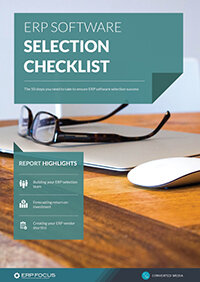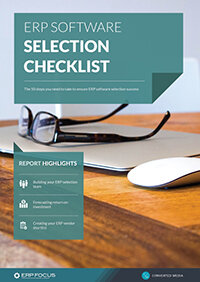Advantages and disadvantages of multi-company ERP
We've previously looked at multi-country ERP implementation at an international level, now let's consider ERP at another level; that of all companies within a group of companies sharing the same system.
The initial reaction of many organizations is that their business units are so diverse that sharing an ERP system is neither possible nor practical, and it is, therefore, better to let them make their own choices. This can sometimes be a valid approach when, for example, the individual companies differ greatly in size and a previous blog on multi-tier systems looks at this in detail.
However; this article was inspired by a multi-billion dollar group of companies that use one (Tier 2) system across all of their divisions, of which they have nine: agriculture, automotive, earthmoving and construction, education, energy, food and beverages, healthcare, industrial gases, and mining. It would be hard to think of business areas more different than agriculture and education, food and beverages, and mining, and automotive, and healthcare, but the system works well for all of them and, when ten years after original go-live they looked at moving at least some units to a Tier 1 system, when they reviewed all options they decided that their existing system was still the best choice for them. So we can continue this blog assuming that diverse industries can share the same ERP system and that that system does not necessarily have to be a Tier 1.
Just because something is possible, though, doesn't always mean that it is the right thing to do; so companies need to look at both the pros and cons, and then make up their own minds. The first thing to consider is costs savings and there are multiple aspects of this. Acquisition costs are an obvious factor because, for example, one ERP license for 1000 users is generally (although not always) cheaper than ten licenses for 100 users.
Check out our ERP cost and budget guide for more information on ERP pricing
But software costs are actually only a small part of overall costs, with consultancy and training being the major components. Consultancy costs can, for the most part, only be reduced when using a common system if all companies are doing pretty much the same thing, although shared experience of overcoming limitations in the software can make a difference. On the other hand, training costs can be significantly reduced. Firstly it may be possible to combine the training of people from several companies into one session and this actually has two extra advantages because it allows small numbers of people from each company to be trained economically (meaning that entire departments don't have to be closed down for training) and it also allows for cross-fertilization of ideas across different operating units.
Secondly, on a phased implementation, staff from Company 1 may be able to help with training at Company 2 etc; further reinforcing cross-fertilization and the strengthening of bonds across the group. Those relationships make the sharing of knowledge and experiences even easier after go-live.
Moving on from costing to increasing profitability in the longer term; a common ERP system makes standardization possible. Standardization starts with having common procedures and ways of working and that allows the sharing of best practices (which can vary significantly from industry to industry) and also opens up the possibility of companies lending staff to each other. That allows companies to help each other with temporary or emergency cover when key staff are absent (whether because of illness, holiday, maternity leave or whatever) and it also allows those staff members to widen their experience and knowledge. That is a benefit that should not be underestimated.
Taking standardization one step further; companies can share inventory coding systems so that the same item has a common identity across the group. That allows management to see where there are excesses and shortages of stock at each operating unit that might be resolved by a stock transfer, and also allows group level purchasing, leading to better prices and discounts on common items.
If work, and not just materials, can be shared because, for example, companies have similar processes and products, then that opens up opportunities to level capacity requirements across manufacturing units. Although not always possible at a finished goods level, it can sometimes be possible at an intermediate or sub-assembly level and it doesn't usually make sense to have some companies short of work whilst others are working overtime. Ultimately, of course, this leads to group-level production planning, leading to further efficiency gains and cost savings, as can happen when work is moved to a site closer to the customer, resulting in reduced delivery costs.
From a sales perspective, common customer coding allows for group-level credit control and potentially also for group-level discount structures to encourage sales. When company culture allows it, it also facilitates up-selling: “Customers who buy this product from us frequently buy this other product from our sister company”.
All of this sounds good but of course, there are down-sides too. When all companies within a group share an ERP system, someone has to decide what that system should be. If the decision is made at a group-level, individual operating units can resent not being part of the process and feel that the chosen system is being imposed upon them; leading to a lack of ownership at the local level. And if the individual companies are part of the decision-making process, then ERP professionals know that if you put six people in a room to discuss ERP, you will get seven different opinions, so the selection process has to be carefully managed. Other complicating factors are that different companies can have differing timescales and priorities; whilst others will inevitably turn up with preconceived ideas and preferences, having preselected a system. These are all challenges that can be overcome.
Lastly; when a group of companies shares a system, and all or many are from different industries or are of differing sizes, it can be necessary to compromise at some point. Some companies may have a real need for ingredient or item traceability whilst others may not. To some, finite capacity scheduling might be a game-changer whilst to others, simple capacity requirements planning might suffice. Some may need complex pricing and discount options, whilst others always sell at list. Not all groups may be as lucky as the example that opened this blog, and it is certainly true that picking a system to satisfy differing requirements requires a level of business intelligence and maturity that not all companies have yet achieved, so the task should not be underestimated.
Finally; the key to selecting the right system is a good written specification or requirements document, sometimes referred to as a Statement of User Requirements (or SOUR). It has to be in writing because, when signed off by the Project Steering Committee, it becomes the agreed statement of what the chosen system has to do and the areas it has to cover. If something is not in the SOUR, it is not in the project unless and until the Steering Committee agrees to it via a formal scope change request. Given that the requirements have to be signed-off by multiple heads of department, verbal specifications simply cannot do the job. Additionally, the completed document forms the basis of a request for proposal (RFP) or invitation to tender (ITT) when it is sent to prospective suppliers and is the measure by which competing systems are judged, so any ambiguity or lack of clarity can be extremely damaging.
It is unlikely that the most senior layer of management will have time to write the SOUR themselves but they absolutely must define, albeit at a high level, what business areas the new system is to cover. Is it to be a full ERP system or does the company need just a new accounting system, or an accounting system with some buy/stock/sell functionality? And should it cover things like HR or warehouse management? They must also set an initial budget, which typically will be between three and five percent of turnover but can be more or less than that depending on the size of the organization. Lastly, they are responsible for ensuring that the project team is made up of the best of the best, and not just the best of what can easily be made available
Future articles look in detail at writing the SOUR, evaluating responses, and building the best project team to ensure success.
Free white paper

60-Step ERP Selection Checklist
Get the comprehensive checklist for your ERP selection project

Related articles
-

What are the benefits of manufacturing ERP?
The advantages of ERP for manufacturing businesses
-

CMMC Compliance: What Aerospace and Defense Manufacturers Need to Know
Key insights on CMMC compliance, deadlines, and securing DoD contracts with CMMC 2.0 certificatio...
-

Using bills of material to solve business problems
BOM functionality is an often overlooked ERP module - but how can it help your business?

